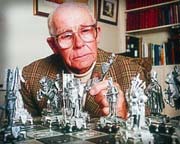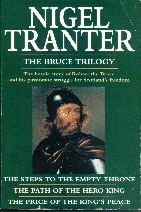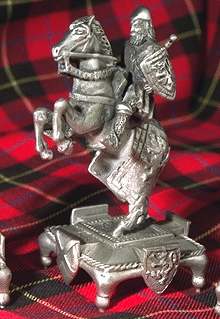![]()
![]()
![]()

You can imagine my surprise when I discovered that the originator of the idea, John Morgan, was someone whose family I had known over thirty years ago in Bridge of Allan. A phone call soon re-established contact with John and the following detailed account of the chess set is the result.
In January 1990, John and Morag Morgan bought the Cornerstone Gallery & Gift Shop in Cathedral Square in Dunblane. There, as well as original Scottish art, they also specialised in Celtic jewellery and other fine gifts.
An artisan designer, Steve Tricket, came into the gallery to ask if the Morgans would like to sell a pewter "Fantasy" chess set that he had designed, modelled and cast. Captivated by the fine detail in the figures and the unusual fact that all the pawns were different from each other they agreed to stock it.

Over the next few years the Morgans sold an extensive number of Steve's 'Fantasy' chess sets but the expansion of the idea, to embrace Nigel Tranter's 'Bruce Trilogy', took hold in John's imagination. As a result he decided to ask Nigel if he would be prepared to put his name to a brand new chess set based on the Battle of Bannockburn.
John had written to Nigel many years before, inviting him to talk as an after dinner speaker at Bridge of Allan Round Table but Nigel had politely declined. Encouraged by Nigel's sincere and friendly response, John had no hesitation in contacting him again to share his thoughts. He wrote to Nigel, spoke to him a few days later and, finding Nigel very receptive to the idea, they agreed to meet at Nigel's home, Quarry House, in Aberlady.
Nigel introduced John to Andrew Spratt, a young costume historian, who was delighted to lend his considerable talent to the project and Steve Trickett, the creator of the Fantasy chess set, agreed to sculpt the figures. All that remained was to decide who would be "starring" in Nigel Tranter’s Bannockburn Chess Set. John and Nigel made those decisions during a long and detailed discussion.
It was obvious who the Scottish King would be but not so for the English one. While Edward II had led the English at Bannockburn, Nigel and John agreed that Edward I, nicknamed Longshanks, had been the catalyst for the hatred which existed between the two countries and the sequence of events which brought them to face each other on the field below Stirling Castle. Thus, he earned his place as the English King.

Similarly, although he had died long before Bannockburn, John felt that William Wallace should be represented as one of Scottish Knights, because of his influence on Bruce, both directly and by example. ( See image on the right.)
Hugh de Cressingham, was loathed by the Scots for, at the very least, the wool tax he introduced while Chancellor of Scotland. Although he died at the Battle of Stirling Bridge in 1297 it was felt that he deserved recognition as one of the English Bishops.
There were other decisions to be made. What were the significant buildings which would represent the rooks? There was perhaps little surprise in the decision to include Stirling Castle, represented by the Inner Gate which can still be seen today; Cambuskenneth Abbey, where Bruce received the surrender of the great Knights and Noblemen who had fought with the English; The Tower of London, where so many noble Scots, including Bruce’s brother and Willlian Wallace, himself, had died; and, Lanercost Abbey, where Edward I died on his way north for one more foray against the Scots.
John Morgan says, "Lanercost Abbey is not the most attractive piece in the set but we can’t redesign history."
Andrew immediately started to research the costume of the 28 characters (excluding the rooks) who would comprise the set. Being identified individuals, the costume detail was readily available for the back row of the pieces, representing the Kings, Queens, Bishops and Knights However, in the case of the Pawns, each of them was given the dress of their own clans, nobles or families. Both John and Nigel were delighted at the incredible detail put into Andrew's drawings, right down to the last lace, buckle or button – correct in every aspect for the period.
Once the drawings were completed, the details were discussed between the three "creators".
John Morgan comments, "That was the most nerve wracking moment of all – we had done everything we could to provide the basic information. We were now making that leap into the unknown. Would Steve be able to recreate the character in Andrew's figures and - given the potential length of development - would he be able to maintain his interest and standards right to the end?"
In the event they need have had no fear as, over the next 18 months, Steve brought the figures to sparkling life. The originals were produced in batches of three or four using "Milliput", a modelling clay which hardens to a stone-like finish when dry.
Each model, as it was completed, was discussed with Nigel, the detail examined, and any changes relayed to Steve. Remarkably, very few adjustments were needed and by the end of 1991, the set was ready to go into production.
Now, John Morgan’s business ethos prevailed. This he describes as "I have always believed there is only one way of doing anything – the best way possible".
This meant the quality of presentation had to match the set itself. Not only did the box have to look good, but it had to be strong enough to transport the 27 kilos (60 pounds) to places such as Canada, America, Australia and the Far East.
To complement the set and complete the package, John sought permission to reproduce chapters twenty and twenty one, from the second book in the Bruce trilogy, "Path of the Hero King", where Nigel describes the Battle of Bannockburn. The resultant 44 page booklet also contains pen drawings of each piece, with the story of the part they played leading up to, and in the Battle itself. Nigel also provided the foreword.
Not content to leave it there, John hired the Scottish actor, James Bryce, to produce a reading of the chapters. This is provided as a 90 minute audio cassette. Said John, "The occasional pipe music heard on the tape, called, "Tranter’s Shout, was provided by my good friend, Pipe Major Sandy Davidson, of Dunblane. He composed it, as one of the occasional pieces, specially for the recording thus adding further to the uniqueness of the product".
The set was finished with a framed Certificate of Authenticity signed by Nigel Tranter and John Morgan, on behalf of Cornerstone. On this aspect John comments "Nigel was very patient. We agreed it would make more sense for him to sign all 500 certificates before the set went into production and this he duly did."
Apart from its beauty and attention to detail, Nigel Tranter’s Bannockburn Chess Set is one of the largest in the world, with the pieces standing between 4" and 5" high. Such a special set demanded a really special playing board.
This resulted in a beautiful 21" playing board, with brushed metal edges and pewter inlaid squares depicting the Thistle of Scotland the Rose of England. The great seals of Robert the Bruce and Edward I take up position as corner pieces.
Since 1992, sales have been steady and, as might be expected, mostly to America. Access to the set is available via the internet ( See below )but can also be seen at the National Wallace Monument. Cornerstone expect to put an additional display set into the Bannockburn Heritage Centre, near Stirling, during 2002.
John concluded, "For all his success and his legacy of outstanding writings, I found Nigel Tranter to be a very modest man who found it rather embarrassing that we should want to attach his name to this work of art. He was a truly epic character in a most unassuming disguise. It was a great privilege to know him and Scotland misses him greatly. Morag and I are so pleased that we asked him to become involved with our project and we like to think that the chess set has become something of a monument to his memory."
NOTE. The Wallace figure shown below is one of the few that John sells individually. In this form it has the castillion base shown in the photograph but the chess pieces have four-footed bases required to straddle the relief-cast squares. ( See the Wallace chess piece above. )

' VIEW THE BANNOCKBURN CHESS SET'
Click on the Wallace effigy, sold separately, to take you to John Morgan's ' Cornerstone Gallery ' for full details of the Bannockburn Chess Set.
Return via your ' back ' button.
